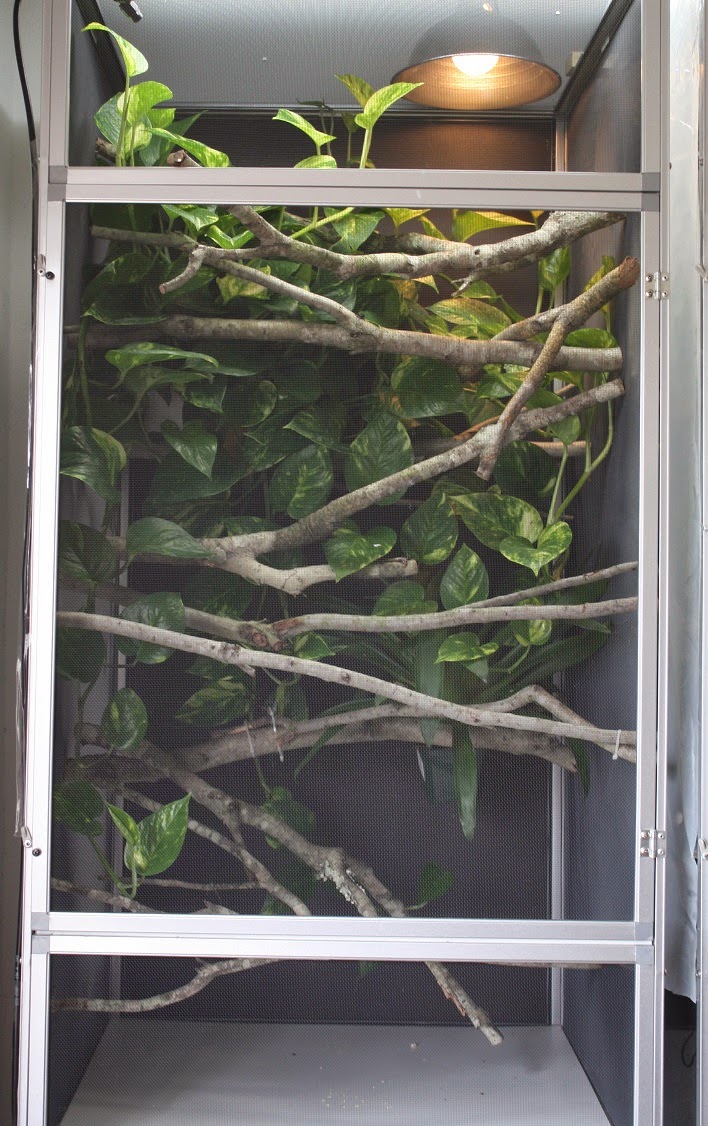Every living thing needs hydration. In the wild, however, standing pools of water can be dangerous to drink from. During rain showers and early mornings,
veiled
chameleons evolved to sip water droplets off the leaves around them. Since they won’t drink from water bowls, keepers must spray a fine mist over the whole enclosure to mimic rain. In addition to hydration, a chameleon needs an ambient humidity of at least 40% and up to 70%. Misting every few hours durring daylight hours will keep moisture levels on track. The methods of misting include:.

There are two uses for water which you much provide. The first is drinking. Placement of plants with respect to the watering system is not an accident. You need water dripping down on the plant leaves and these leaves nearby convenient perching branches. Once the entire cage is together you may have to adjust some placements to ensure maximum use of the water coming down. The second use of water is hygiene. Chameleons need a good rain to keep their eyes clean. This is the reason why drippers are not a full solution. If you are using a dripper to provide drinking water you will have to consider a weekly drench in the shower to allow body cleaning.
Humidity level for Chameleons
When it comes to panther chameleon care, the cage you select is more than just a container; it’s their entire world. Here’s why choosing the right cage is paramount:
space matters: panther chameleons are arboreal creatures, meaning they spend most of their lives in trees. A tall, vertically oriented cage allows them to exhibit their natural climbing behavior and provides ample space for movement. Ventilation is key: proper ventilation is essential to maintaining the right humidity levels and preventing the buildup of stagnant air.
 Screen-sided cages strike a balance between airflow and containment. Safety and security: a well-constructed cage keeps your chameleon safe from potential predators and household hazards.
Screen-sided cages strike a balance between airflow and containment. Safety and security: a well-constructed cage keeps your chameleon safe from potential predators and household hazards.
Drue tibbits last modified date: october 02, 2023 drue tibbits last modified date: october 02, 2023 the health and longevity of chameleons kept in captivity depend, in part, on the setup of their enclosures. Chameleons need safe, clean enclosures of the correct size, structures for climbing, and temperature regulation of their cages. They also need proper light and water sources. Some chameleons may require humidity regulation as well. Most chameleon species do well in reptile screen enclosures. The screen allows air movement within the cage and helps prevent fungal growth or infections that may result from trapped humidity. Rhampholia and brookesia species are exceptions; most of these types of chameleons require high humidity levels and do better in enclosures with glass sides.
Do Chameleons need heat lamps at night?
Reptiles are ectothermic, meaning they require an external heat source for the metabolic processes. In the wild, veiled chameleons bask themselves under the hot sun and hide under the shades to escape from the high temperature. You need to create a surrounding that can mimic the natural environment. Light sources can be a heat source. If you have the light as the heat source during the day, you need to turn it off and use a heat emitter during the night. However, using a dedicated heat source to create a basking spot is better as it can regulate the body temperature more effectively.
Panther chameleons are most active during the day, so they need a proper lighting system to truly thrive. Your lights will simulate the day and night cycle while also providing some much-needed heat. Like most reptiles, panther chameleons self-regulate their body temperature. To support that behavior, you have to use your lights to create a temperature gradient. In one of the top corners of the enclosure, position a basking light. The light should not touch the enclosure or be accessible by the lizard. Use the light to raise temperatures in this basking corner to 90 degrees fahrenheit. On the cooler side of the enclosure, ambient temperatures should be around 75 degrees.
Lighting our chameleon cages is an involved execution as we break sunlight up into three different lamps: light for vision, heat, and uvb. Not only do we need to co-ordinate strengths of these light sources, but we need to place them in a limited physical area above our cage where they jockey for space with mist heads, foggers, fans, and whatever else we need to create an appropriate environment. In this module we will review implementing the three functions of replicating the sun. The most involved will be uvb. As mentioned, the common challenge will be not only determining the right strength and shape bulb, but in finding a place to set them for full benefit.
Pygmy chameleons don’t require anything fancy when it comes to both temperature and lighting. Unlike most pet reptiles, they don’t really need a temperature gradient or supplemental uvb lighting. This could be because in the wild, pygmy chameleons live on the forest floor and don’t need as much uvb as arboreal chameleons. They like a temperature between 65 and 80 degrees fahrenheit. The ideal sweet spot is usually around 70°f (aka room temperature). Expert tip: it’s very important to never let the temperature of the enclosure go above 80 degrees fahrenheit. Basking lights or under-the-tank heaters are totally unnecessary.
